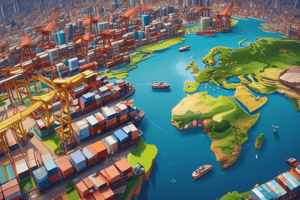Podcast
Questions and Answers
What describes a trade surplus?
What describes a trade surplus?
- Exports are less than imports
- Exports are equal to exports
- Exports equal imports
- Exports exceed imports (correct)
What is the primary purpose of licensing in business?
What is the primary purpose of licensing in business?
- To grant permission to use a brand for a fee (correct)
- To create a joint venture
- To limit the production of goods
- To directly control all brand operations
What is a characteristic of a foreign subsidiary?
What is a characteristic of a foreign subsidiary?
- It is a joint venture with local firms
- It operates independently from the parent company
- It is owned by the parent company in a foreign nation (correct)
- It is controlled by local laws only
Which of the following is NOT a benefit of a joint venture?
Which of the following is NOT a benefit of a joint venture?
How does FDI typically benefit a host country?
How does FDI typically benefit a host country?
Which force does NOT typically affect global trade?
Which force does NOT typically affect global trade?
What is an embargo?
What is an embargo?
What is countertrading?
What is countertrading?
What is the primary benefit of free trade?
What is the primary benefit of free trade?
Which of the following describes comparative advantage?
Which of the following describes comparative advantage?
What is a major negative aspect of importing and exporting?
What is a major negative aspect of importing and exporting?
Absolute advantage refers to a country's ability to:
Absolute advantage refers to a country's ability to:
Which effect is commonly associated with free trade agreements?
Which effect is commonly associated with free trade agreements?
What can be a consequence of forced price reductions due to free trade?
What can be a consequence of forced price reductions due to free trade?
What does it mean when a country has a comparative advantage?
What does it mean when a country has a comparative advantage?
One of the advantages of importing goods includes:
One of the advantages of importing goods includes:
Which is NOT a negative consequence of trade?
Which is NOT a negative consequence of trade?
Flashcards
Importing
Importing
Buying goods from other countries.
Exporting
Exporting
Selling goods to other countries.
Free trade
Free trade
Unlimited importing and exporting with no restrictions.
Positives of trade
Positives of trade
Signup and view all the flashcards
Negatives of trade
Negatives of trade
Signup and view all the flashcards
Comparative Advantage
Comparative Advantage
Signup and view all the flashcards
Absolute Advantage
Absolute Advantage
Signup and view all the flashcards
Production growth
Production growth
Signup and view all the flashcards
Economic growth
Economic growth
Signup and view all the flashcards
Trade Surplus
Trade Surplus
Signup and view all the flashcards
Dumping
Dumping
Signup and view all the flashcards
Licensing
Licensing
Signup and view all the flashcards
Franchising
Franchising
Signup and view all the flashcards
Joint Venture
Joint Venture
Signup and view all the flashcards
Foreign Direct Investment (FDI)
Foreign Direct Investment (FDI)
Signup and view all the flashcards
Tariffs
Tariffs
Signup and view all the flashcards
Trade Protection
Trade Protection
Signup and view all the flashcards
Study Notes
Importing and Exporting
- Importing: Buying goods from other countries.
- Exporting: Selling goods to other countries.
- Free Trade: Unrestricted exchange of goods and services between countries.
- Benefits of Free Trade: Increased production, lower prices, economic growth, and wider availability of goods.
- Drawbacks of Free Trade: Job losses in some sectors, reduced competitiveness for some domestic companies, and pressure to lower domestic prices.
Comparative and Absolute Advantage
- Comparative Advantage: A nation should specialize in producing and exporting goods it produces most efficiently, and import goods it can't produce as efficiently.
- Absolute Advantage: A nation has a monopoly or produces a given product more efficiently than all other nations.
Balance of Trade (BOT) and Balance of Payments (BOP)
- Balance of Trade (BOT): The difference between a country's exports and imports over a period of time.
- Trade Surplus: Exports exceed imports.
- Trade Deficit: Imports exceed exports.
- Balance of Payments (BOP): The difference between a country's money received from exports and money paid for imports.
Unfair Trade Practices
- Dumping: Selling goods in another country at a price lower than the cost of production.
Entering the Global Market
- Licensing: Granting permission to another company to use a brand or intellectual property in exchange for payment.
- Franchising: Allowing another company to operate using a brand and business model. More control is maintained by the original company compared to licensing.
- Export Assistance Centers (EAC): Support for small/medium businesses to export their products directly.
- Export Trading Companies (ETC): Facilitate indirect exports for businesses.
- Contract Manufacturing: Hiring a factory in another country to produce goods for your own brand.
- Joint Ventures: Collaboration between two or more companies for a project. Benefits include shared knowledge, resources, and risk.
- Strategic Alliances: Long-term partnerships to share resources (capital, technology) and reduce certain risks for mutual benefit.
- Foreign Direct Investment (FDI): Investing in a permanent business presence in foreign countries.
- Foreign Subsidiary: A business that's part of a larger company (the parent company) but located in another country.
- Multinational Corporations (MNCs): Corporations operating in multiple countries.
- Sovereign Wealth Funds: Investments controlled by a government for investment in foreign companies.
Forces Affecting Global Trade
- Cultural Forces: Language and religious differences can affect trade.
- Exchange Rates: Value of one currency compared to another.
- Devaluation: A deliberate lowering of currency value.
- Countertrading: Trading goods or services for goods or services rather than using money.
- Legal Forces: Differences in laws and regulations across countries.
- Environmental Forces: Issues, such as environmental regulations and difficulties with international shipping.
- Trade Protectionism: Government restrictions on imports to benefit domestic industries.
- Tariffs: Taxes on imported goods.
- Import Quotas: Limits on the quantity of imported goods.
- Embargoes: Complete ban on import or export of certain goods.
- Gatt (General Agreement on Tariffs and Trade): A predecessor to the WTO that worked reducing restrictions on imports and exports.
- Common Market: A regional group of countries with free trade and common economic rules.
Studying That Suits You
Use AI to generate personalized quizzes and flashcards to suit your learning preferences.




